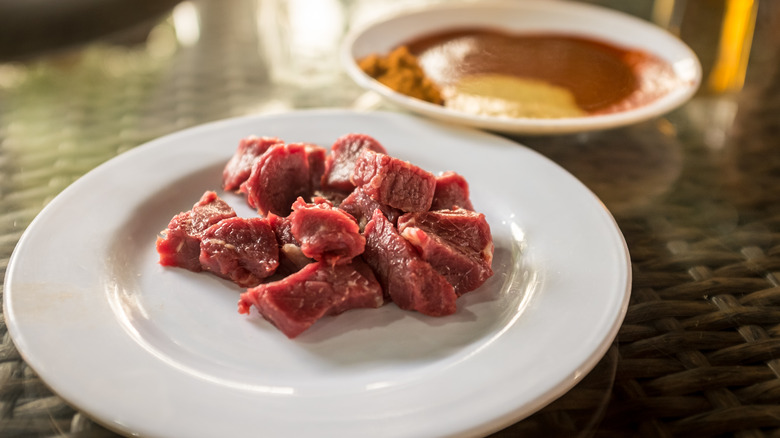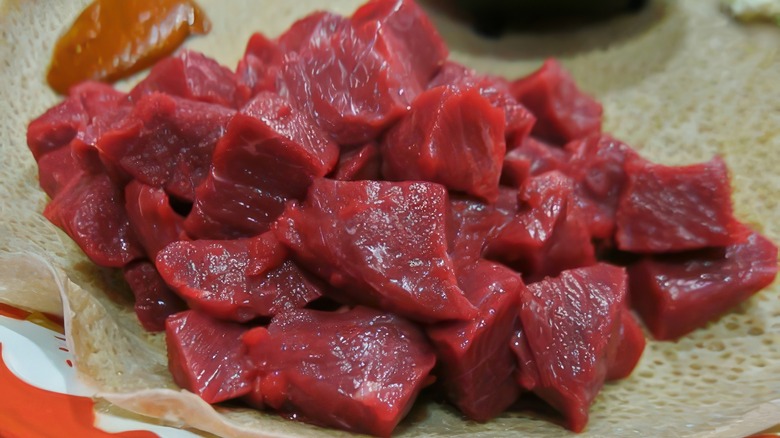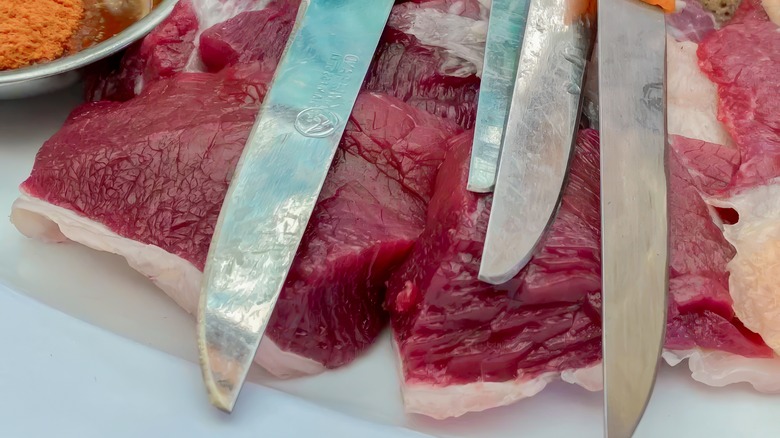Tere Siga Is An Ethiopian Delicacy With A Significant Cultural History
If you enjoy learning about the foods of other cultures — especially when it's different from what you're used to — then you'll likely be interested in hearing about tere siga, a delicacy of Ethiopia that likely dates back centuries.
Tere siga is an Amharic term that translates directly to "raw meat," which is exactly what the dish is. Depending on where you're from, your palate might be unaccustomed to eating raw meat, but it's one of Ethiopia's most popular dishes. Tera siga is a communal dish meant to be shared by about two or three people and consists of strips of raw meat, typically beef. If you're curious to try it out for yourself, you can get tere siga in the U.S. — but keep the health risks in mind, such as contracting a foodborne illness like salmonella. For example, Merkato, an Ethiopian restaurant in Los Angeles, is one place where you can order tere siga in America.
How is tere siga served?
The raw beef of tere siga is typically served with bread, and there's a good chance that it will be served atop a traditional Ethiopian flatbread called injera. Additionally, it's often dipped in mitmita (a mix of spices, such as cumin, allspice, and cinnamon), a mustard sauce called senafich, or a spicy sauce called awaze.
While many Ethiopian dishes are eaten with your hands, eating tere siga requires a knife to cut the meat strips into bite-sized pieces. In fact, the process of cutting is a ritual called q'wirt, which comes from the Amharic word "q'warata" meaning "to cut." Ayele Solomon, an Ethiopian-American, told the Los Angeles Times, "The cutting is part of the ceremony. You don't want someone else's filthy hands touching it."
In Ethiopia, you can find tera siga at a "siga bet," which translates to "meat house." You can find many siga bets around the country. There, diners eat right where the meat is butchered. The butcher will cut the meat to the guest's request, such as in cubes or in strips. The most valued piece of meat is the tenderloin, or "chikena" in Amharic.
If you're worried about the health risks of eating raw meat, you can request that tere siga be cooked, which actually turns it into a different dish called tibs.
Ethiopians have a long history of eating raw meat
While there is no definitive account of when exactly Ethiopians began eating raw meat, different stories about the practice date back several centuries and often describe it as a survival tactic. Supposedly, Ethiopian soldiers first began eating raw meat during the 16th century Abyssinian-Adal War as a way to draw less attention to themselves by eating raw meat instead of starting a fire to cook it. A similar story claims that Ethiopian civilians were trying to hide from Italian colonizers when they began skipping the fire and eating their meat raw.
Regardless of which historical account is correct, raw meat has remained a central part of Ethiopia's food culture throughout the years. Siga bet owner Atnaf Kebede told Vice, "It's just our culture to eat this way. For me personally, I find it easier to eat raw meat than salad. Salad feels heavier and harder to digest." Another individual told Vice that eating raw meat makes him feel strong and can sate his appetite for an entire day.
Notably, eating raw meat is more closely associated with men than women in Ethiopia. Berhanu Asfaw, an Ethiopian transplant who owns a restaurant in Los Angeles, told the LA Times that in addition to the good taste: "It also makes you more macho, and they like that." Plenty of women still indulge in tere siga but may be more likely to only eat it at gatherings rather than seeking it out independently.


